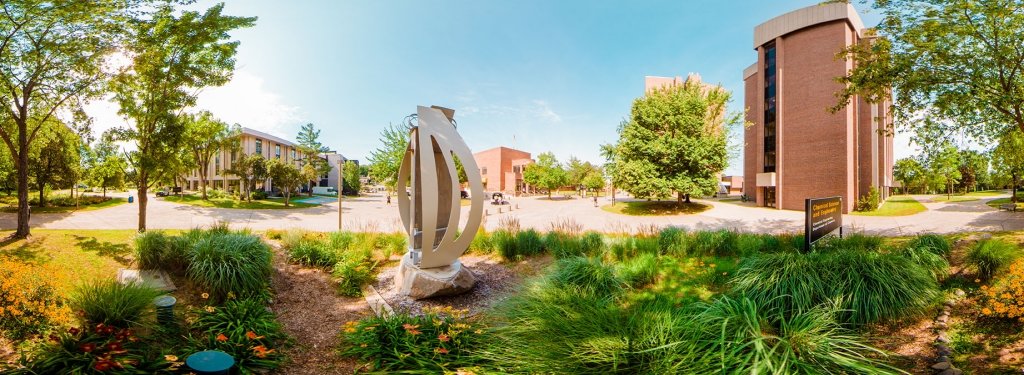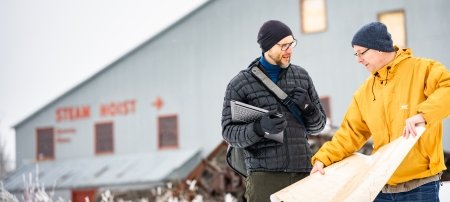Green Campus Enterprise Working to Lighten University's Carbon Footprint
The Michigan Technological University community generates greenhouse gases equal to about 73,000 tons of carbon dioxide a year, according to a study recently completed by the Green Campus Enterprise. That's about 10 tons for every student and employee on campus.
So much for the bad news. The good news is that wind power and other green measures may have the potential to lighten Tech's ponderous footprint.
During spring semester, the Green Campus Enterprise conducted a three-pronged effort aimed at cutting the University's generation of greenhouse gases. First, the team wanted to find out just what those emissions are. Using the Clean Air–Cool Planet Campus Carbon Calculator ( see Clean Air-Cool Planet ), one team completed a baseline study showing that emissions of six greenhouse gases totaled 72,843 tons (66,082 metric tons, according to the report) in 2007-08. By far the largest share--47 percent--results from electricity from utility companies.
The team's advisor, Chris Wojick, called the study "an important first step."
"Many universities are still striving to do this," said Wojick, a senior research engineer in the civil and environmental engineering department. "Getting a handle on your greenhouse gas emissions is essential. If you don't, you can't really know what impact your reduction measures will have."
Second, the Campus Culture Team surveyed the University community to gauge support for sustainability efforts and suggest strategies to cut emissions. Lastly, the Enterprise hopes to lay the groundwork for the possible installation of wind turbines to generate electricity on campus.
Jessica Banda, a scientific and technical communication major, leads the Campus Culture Team. Through its Green Building Initiative, piloted in the Noblet Forestry Building, the team encouraged students, faculty and staff using the building to take simple steps to reduce their carbon emissions, such as recycling and cutting back on energy and water use. They also reviewed an energy audit that suggested energy-saving opportunities, such as installing low-flow fixtures in the restrooms.
"We are also planning an energy savings competition," she said, similar to Eco-Olympics held at other universities. "Residence halls will compete against each other to see who can save the greatest amount of energy."
In addition, the team has investigated technologies such as the Lucid Design Group Building Dashboard, a web-based application that allows members of a community to track their energy use in real time and take steps to conserve.
The Campus Culture Team has met with the leaders of campus organizations committed to sustainability. "We plan to collaborate on mutual goals rather than work separately," Banda said. "We want to unite the organizations in a collective quest to reduce carbon emissions."
Charles Workman, a chemical engineering major, leads the wind power group. "Electricity accounts for 47 percent of Michigan Tech's carbon footprint, and wind energy can reduce it significantly."
The team has begun studying wind turbines as a source of power and is requesting funding for a year-long study of wind speed and direction to determine the cost and benefits of installing wind power on or near campus.
Surveys showed extensive support for wind power within the campus community, but some have expressed concerns about their appearance, issues of eminent domain and right-of-way, and the turbines' potential for endangering wildlife. The group has consulted the Keweenaw National Historical Park, the US Fish and Wildlife Service and the National Wind Coordinating Committee for advice on addressing socio-economic and environmental concerns.
They will continue to look into other aspects of campus operations for other ways to reduce greenhouse gas emissions.
"They've done exceptional work, especially considering spring 2009 was the startup semester for the Enterprise," said Wojick. "They are very dedicated people."
The students point to the Green Campus Enterprise as the catalyst for their effort. "Chuck and I have been studying leadership, and we couldn't have had a better practical experience in leadership than this," said Banda.
"What was most exciting is that we've been able to create this on our own," Workman said, adding, "It's great to work with people whose motivation comes from within."
Michigan Technological University is an R1 public research university founded in 1885 in Houghton, and is home to nearly 7,500 students from more than 60 countries around the world. Consistently ranked among the best universities in the country for return on investment, Michigan's flagship technological university offers more than 185 undergraduate and graduate degree programs in science and technology, engineering, computing, forestry, business, health professions, humanities, mathematics, social sciences, and the arts. The rural campus is situated just miles from Lake Superior in Michigan's Upper Peninsula, offering year-round opportunities for outdoor adventure.




Comments